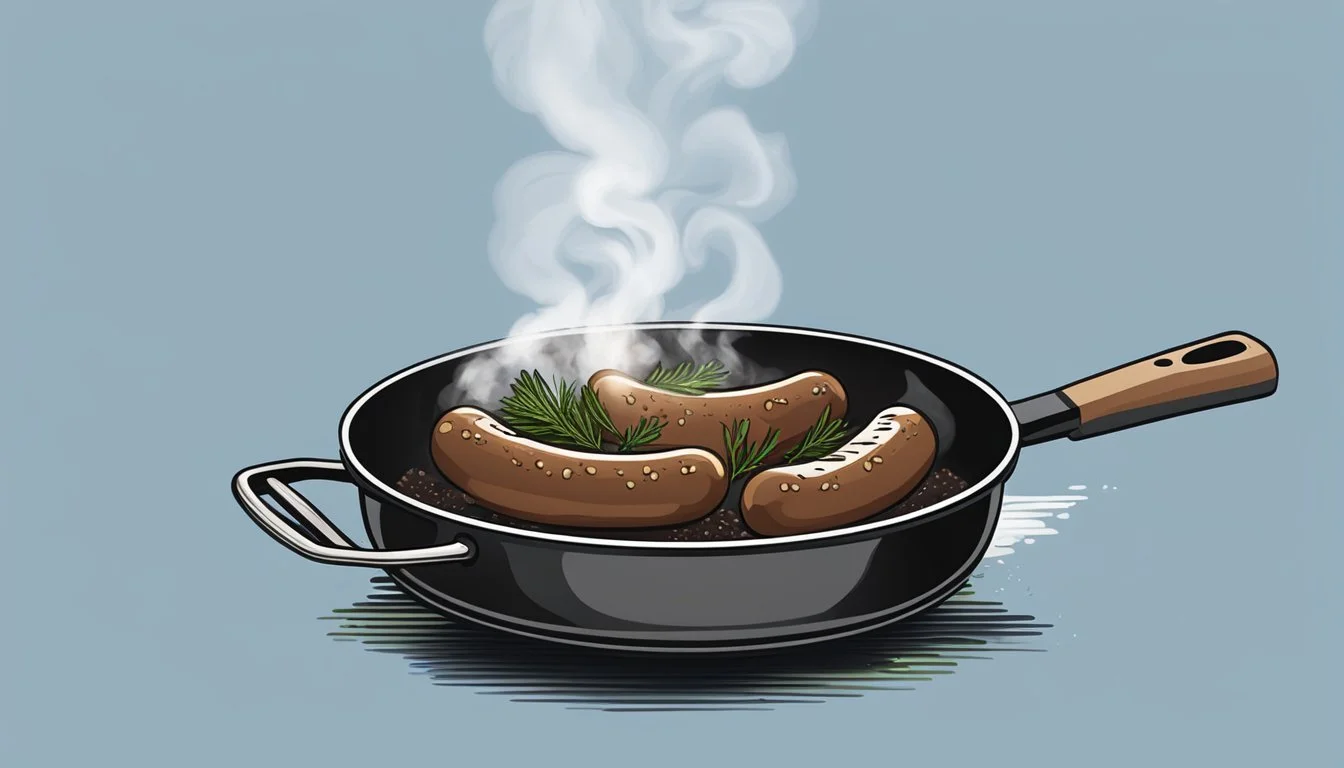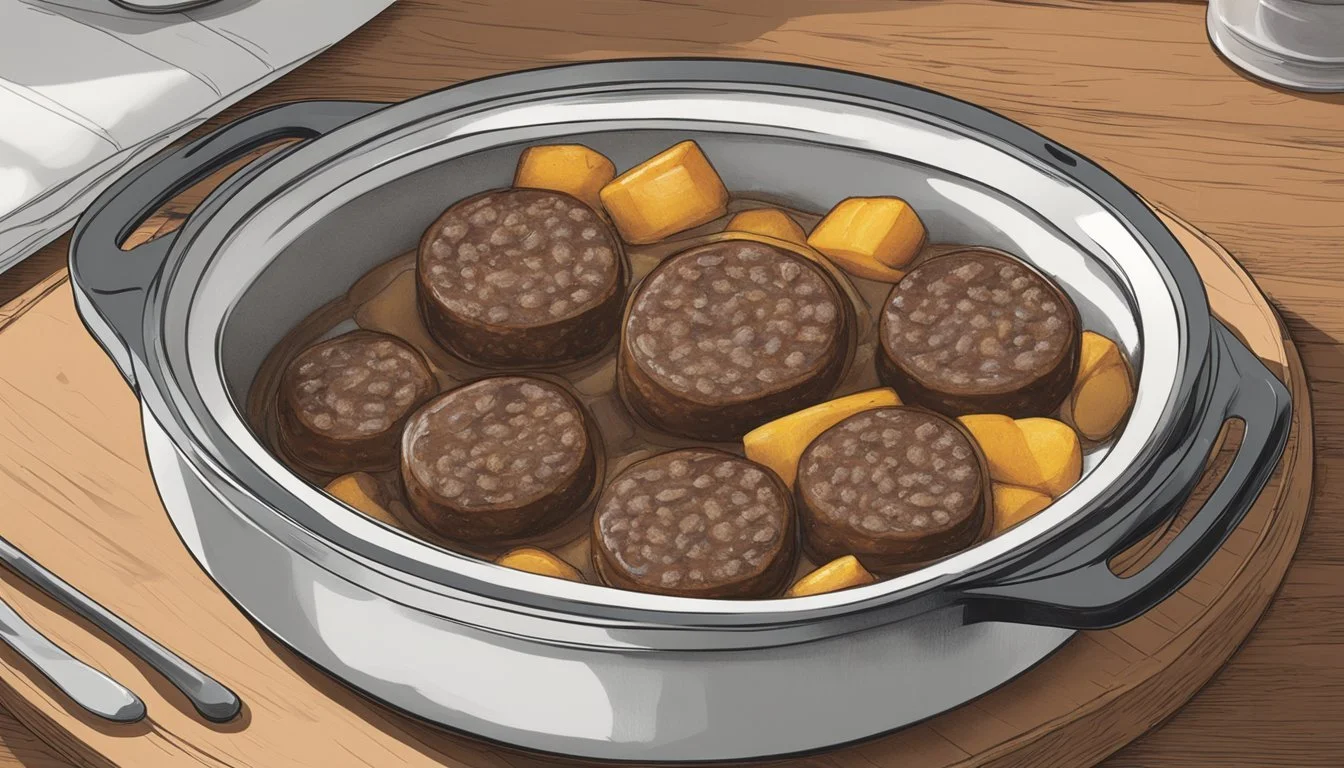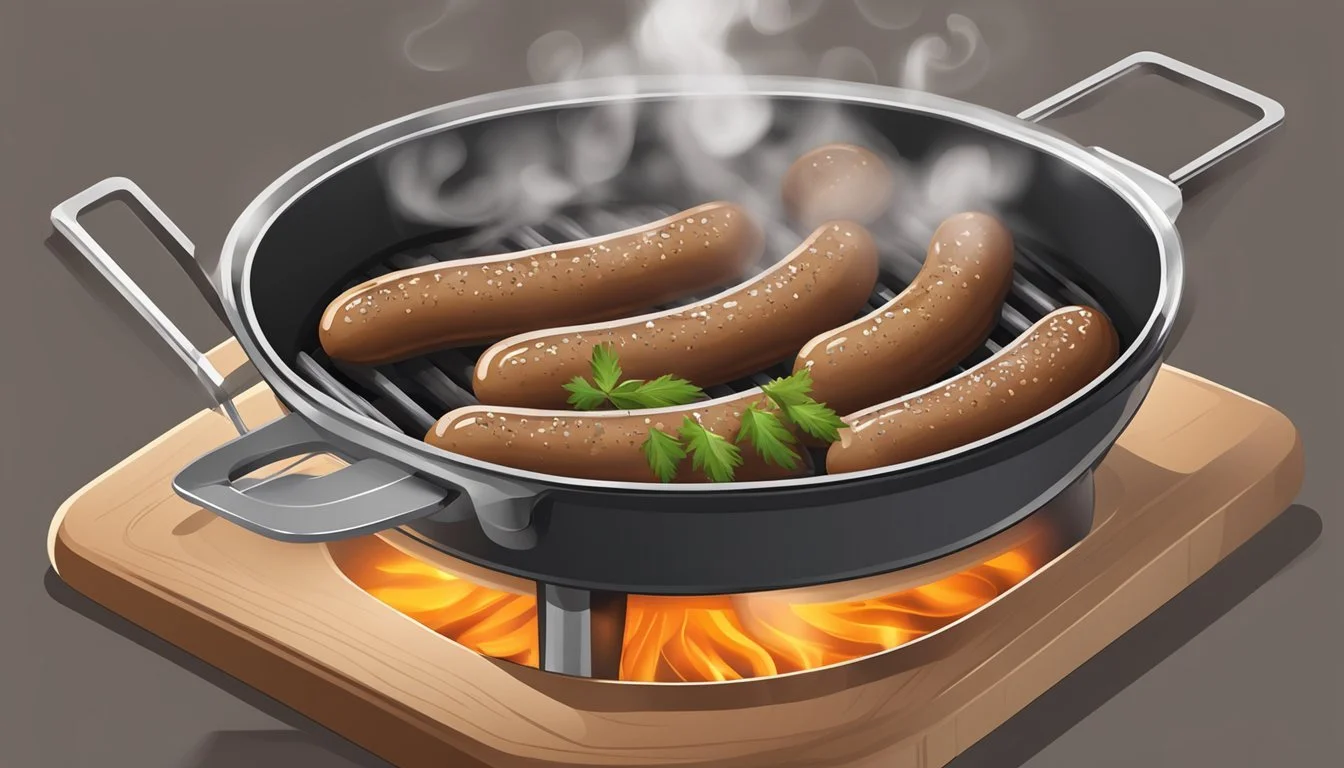Best Way to Reheat Venison Sausage
Ensuring Tenderness and Flavor Retention
Reheating venison (What wine goes well with venison?) sausage can be a bit of a culinary challenge as the goal is to maintain its tenderness and rich flavor. Venison, known for its lean quality, can easily become tough and gamey if not reheated properly. Therefore, it's crucial to understand the best ways to warm up this delicate meat while preserving its succulence and taste. Key to this process is the application of gentle heat and moisture control.
When it comes to venison sausage, a low and slow reheating approach is favored. This helps in keeping the sausage tender and ensures that the flavors are not compromised. One of the most effective methods includes using the oven, which provides consistent heat and allows for even warming. The technique involves preheating the oven to a moderate temperature, placing the sausages in a covered dish with a bit of liquid to prevent drying out, and heating them until just warmed through. The careful monitoring of the internal temperature is also important to avoid overcooking.
Maintaining quality during reheating is pivotal for a satisfying venison sausage experience. It's not just about reaching the safe eating temperature, but also about protecting the nuanced flavors characteristic of venison. There's a balance between food safety and culinary finesse, and achieving it means adhering to precise time and temperature control. Through proper reheating technique, venison sausage can be restored to its original state of tenderness, ready to be enjoyed as if freshly cooked.
Understanding Venison Sausage
Venison sausage is made from the meat of deer, which is known as venison. This meat is appreciated for its rich flavors and is often used in sausage-making due to its hearty taste and texture. Venison is a type of lean meat, containing less fat compared to beef or pork, which contributes to its characteristic gamey taste.
When discussing nutritional content, venison stands out as a substantial source of protein, making it a valuable addition to a protein-rich diet. It is also high in iron, which is beneficial for blood health. Generally, venison sausage will have lower cholesterol and calories than sausages made from other types of meat, which can make it a healthier option for those conscious about their dietary intake.
Nutrient Benefit Protein Supports muscle health Iron Boosts blood production Cholesterol Lower levels compared to other meats Calories Less, beneficial for weight management
The texture of venison sausage is usually firmer than other meat sausages due to the low fat content. The sausage can have a range of flavors depending on the spices and seasonings used, and it's common to add pork or another fattier meat to the mix to enhance both taste and texture.
It’s essential to understand these aspects of venison sausage to execute proper storage and reheating methods that maintain its tenderness and flavorful qualities.
Preparation for Reheating
Before reheating venison sausage, proper preparation is essential to ensure that its tenderness and flavor are preserved. The keys to successful reheating begin with the correct thawing process, employing adequate storage techniques, and avoiding freezer burn.
Thawing Venison Sausage
To thaw venison sausage, always use the refrigerator for a slow and safe defrost. This method preserves the sausage’s texture and prevents bacterial growth. Depending on the sausage size, thawing might take 12 to 24 hours. It's critical not to rush this step by using higher temperatures, as it could lead to uneven thawing and potential loss of flavor and juiciness.
Proper Storage Techniques
Once thawed or if storing cooked venison sausage, wrap it tightly in freezer paper or place it in a freezer bag to prevent air exposure. Remove as much air as possible from the freezer bag to maintain the sausage's integrity. These storage methods also apply to fresh sausage that is not yet cooked.
Refrigerator: Store cooked venison sausage in the refrigerator for up to three days.
Freezer: For longer storage, the freezer is suitable for up to three months.
Avoiding Freezer Burn
Freezer burn can significantly compromise the quality of venison sausage. To prevent this:
Wrap the sausage tightly in freezer paper, followed by a layer of aluminum foil.
Ensure no part of the venison sausage is exposed to air.
For added protection, place wrapped sausage in a freezer bag.
Label and date the sausage before freezing, and consume it within the optimal storage window to enjoy its best quality.
Reheating Methods
Choosing the right reheating method is crucial for ensuring venison sausage retains its tenderness and flavor. Below are various techniques with specific instructions to achieve the best results.
Oven Reheating Technique
For oven reheating, preheat the oven to 250°F (120°C). Place the venison sausages on a baking sheet lined with aluminum foil and cover them tightly with another piece of foil. This helps retain moisture during the cooking process. The sausages should heat for about 20-30 minutes per pound, until the internal temperature reaches around 130°F (54°C) if aiming for medium-rare doneness.
Stovetop Reheating Method
When reheating venison sausage on the stove, one should use a skillet or pan over low heat. To prevent sticking, add a small amount of water or stock to the pan, and cover to help steam the sausage, this keeps the moisture intact. This method usually takes about 10-15 minutes, turning the sausages halfway through to ensure even heating.
Microwave Reheating Tips
Microwaves offer a quick reheating option. To reheat venison sausage efficiently, place them on a microwave-safe plate and cover with a damp paper towel. Heat on medium power in 30-second intervals, turning the sausages each time to promote even reheating. The total time should not exceed 1-2 minutes to avoid overcooking.
Using Sous Vide for Reheating
The sous vide method entails sealing the venison sausage in a vacuum sealer bag and placing it in a water bath. Set the sous vide device to the desired temperature, typically 140°F (60°C) for reheating without overcooking. This method can take 30 minutes to an hour but will ensure that the sausages maintain their juiciness and flavor.
Maintaining Moisture and Texture
When reheating venison sausage, maintaining moisture ensures that the meat remains tender and the texture pleasant. For best results, careful attention should be given to the reheating process to sustain the sausage's succulence.
Adding Moisture During Reheating
Marinating: Before reheating, one can marinate the venison sausage to add moisture and flavor. A marinade made with oil, vinegar or citrus juice, and herbs can infuse the sausage with additional moisture.
Use of Broth or Stock: For an oven reheating method, placing the sausage in a dish with a small amount of broth or stock can help retain moisture during the reheating process.
Preventing Drying Out
Steam: To reheat on the stovetop, the use of steam can be an excellent method to prevent the sausage from drying out. One can add water to the pan and cover it to create steam while reheating.
Fat: Including a small amount of fat, such as butter or oil, when reheating can help to keep the venison sausage moist and improve texture. Adding moisture is crucial, as it enhances tenderness and prevents the sausage from becoming tough or chewy.
Safety and Best Practices
When reheating venison sausage, prioritizing safety ensures that the meat remains tender, flavorful, and free from harmful bacteria. Adhering to best practices concerning temperature control, cross-contamination prevention, and spoilage identification is crucial.
Monitoring Temperature
Temperature Control: The use of a meat thermometer is essential when reheating venison sausage to prevent overcooking and to ensure food safety. Venison sausage should be reheated to an internal temperature of 160°F to effectively eliminate bacteria while maintaining tenderness.
Steps for Monitoring:
Insert a food thermometer into the thickest part of the sausage without touching the pan or bone.
Check the temperature halfway through the reheating process to gauge how quickly it is warming.
Preventing Cross-Contamination
Hygiene Measures: To avoid cross-contamination, which can spread bacteria and cause foodborne illness, separate cooking utensils and surfaces should be used for cooked and uncooked foods.
Prevention Tips:
Use separate cutting boards for raw meat and other ingredients.
Consider using color-coded utensils to keep raw and cooked foods apart.
Wash hands, utensils, and surfaces with hot, soapy water immediately after handling raw meats.
Identifying Spoilage
Signs of Spoilage: Detecting spoilage before consuming reheated venison sausage is critical for food safety. Signs to look for include an off odor, discoloration, and a slimy texture.
Spoilage Indicators:
Odor: A sour or ammonia-like smell is an immediate indicator that the venison sausage may have spoiled.
Discoloration & Texture: Any unusual changes in color or a sticky or slimy film on the surface of the sausage suggest that it should not be consumed.
Alternative Reheating Techniques
In addition to traditional oven reheating, there are effective alternative methods that may better retain the tenderness and flavor of venison sausage.
Slow Cooker Warming
For a gentle reheating approach, one can use a slow cooker. To reheat venison sausages, place them in the slow cooker and set it on a low heat setting. It is recommended to add a small amount of broth or water to create a moist environment, preventing the sausages from drying out. One could also wrap the sausages in a damp paper towel to further ensure moisture retention. This process may take several hours, making it suitable for gradual reheating.
Grilling for Reheating
Grilling can impart a smoky flavor to venison sausages that oven reheating cannot. Preheat the grill to a low-medium setting to avoid burning the sausages. Arrange the sausages on the cooler part of the grill and turn them frequently for even reheating. It is crucial to monitor the sausages closely as grilling can quickly go from reheating to overcooking.
Pan-Fry Reheating
Using a pan for reheating venison sausages offers a quick and efficient method. Heat a pan over a medium-low flame and add a small amount of cooking oil or butter to prevent sticking. Place the venison sausages in the pan and turn them occasionally, allowing each side to gently warm through. Using a lid to cover the pan can help distribute the heat more evenly. If sausages start to brown too quickly, reduce the heat.
In each of these alternative techniques, using a baking tray or another appropriate surface for the specific method ensures the venison sausages are reheated evenly and to one's desired temperature, without the loss of their natural flavors and succulence.
Enhancing Flavors Post-Reheating
After reheating venison sausage, one can further maximize its flavors by adding spices and seasonings or incorporating the sausage into casseroles.
Using Spices and Seasonings
To elevate the taste of venison sausage, it's recommended to sprinkle a mixture of seasonings onto the meat.
Recommended Seasoning Mix:
Salt: A pinch will enhance the natural flavors.
Pepper: Freshly ground black pepper adds a slight heat and pungency.
Garlic Powder: Half a teaspoon imparts a warm, savory note.
Rosemary: This herb will give a piney aroma and a sharp flavor.
Thyme: Adds a subtle, earthy undertone to the meat.
When applying these seasonings, one should adjust the quantity to preference but remain cautious to not overpower the venison's natural richness.
Creating Sausage Casseroles
Venison sausage casserole presents a method to not only reheat but also add moisture and flavor.
Simple Casserole Recipe:
Ingredients:
Cooked venison sausage, sliced
Your choice of vegetables (e.g., bell peppers, onions)
A creamy soup base or stock
Seasonings: salt, pepper, thyme, rosemary
Shredded cheese (optional)
Instructions:
Layer the bottom of a baking dish with sausage and vegetables.
Pour over the soup base or stock to just cover the contents.
Season with salt, pepper, rosemary, and thyme.
Optionally, top with cheese for a richer taste.
Bake in a preheated oven at 350°F until bubbling and golden on top.
By integrating the venison sausage into a casserole, one not only reheats the sausage but also infuses it with the added flavors from the other ingredients, resulting in a tender and tasteful dish.
Conclusion and Recap
When reheating venison sausage, the key is to maintain its tenderness and flavor. Oven reheating is recommended because it heats the sausage evenly, reducing the risk of drying it out. Chefs should preheat their oven to a moderate temperature, generally 250°F (120°C), and wrap the venison sausages in foil to keep the moisture locked in.
For those preferring quicker methods, microwaving is a viable option, especially when time is of the essence. Chefs should arrange the sausages on a microwave-safe dish, covering them with damp paper towels to add moisture.
Here are the condensed steps for both methods:
Oven Reheating:
Preheat the oven to 250°F (120°C).
Wrap venison sausages in foil.
Heat until the internal temperature reaches the desired level, typically around 130°F (54°C) for a medium-rare outcome.
Microwave Reheating:
Place sausages in a single layer on a dish.
Cover with damp paper towels.
Reheat in short intervals, checking frequently to avoid overcooking.
Whether chefs choose the oven or microwave, they must ensure the sausage reaches a safe internal temperature before consumption. By following the outlined steps, venison sausages can be reheated successfully, retaining their juiciness and delectable taste.






